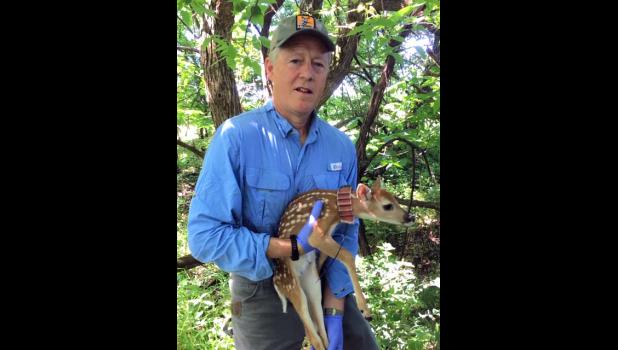Outdoor Journal Fawn Time part 2
Last week we talked about this being the time of year that fawns are being born. When you come into the world at around 5 pounds, are deposited in a thick patch of brush, and you have yet to learn to walk or run, there are things out there that will readily eat you. Black bears in the northern part of the whitetails range regularly prey on new fawns. Bobcats, coyotes and free running dogs are the primary predators in this part of the country.
Knowing how many deer are harvested each year is critical to managing the states deer herd. That is why hunters are required to register their deer kills. Equally as important is having a good handle on how many deer are born each summer and how many survive to hunting season. In the age of CWD, Chronic Wasting Disease ( the fatal deer disease, not to be confused with EHD Epizootic Hemorrhagic Disease, usually referred to as Blue Tongue.), knowledge of how far deer disperse is critical as well.
The joint study by the MU School of Natural Resources and the Missouri Department of Conservation is in it’s 5th and final year of collecting data via GPS collard deer, will shed some light on each of these questions. Adult deer captured during the winter have been fitted with GPS collars for each of the last 5 winters. Pregnant doe deer that were captured had small transmitters implanted that send a signal when it senses temperature change after passing out of the birth canal when a fawn is born. Somewhere in the vicinity of that transmitter, a fawn (or fawns) is hiding in the underbrush. Currently, teams of researchers are locating those fawns in the two study areas, one in NW Missouri and one in South Missouri.
Last year June I was able to tag along with the north Missouri team as they went in search of a transmitter and fawns along the Gentry-DeKalb county line.
I met the research crew along the county road and rode with them onto the private property where they had permission to conduct their research and had caught deer during the winter. We had a good idea where the signal was coming from by looking at a satellite map. After a short hike on foot, we observed the doe sneaking out of sight. After a quick check with their signal detecting equipment that looked similar to an old TV antenna, we quietly moved in to the brushy ditch. Using long sticks to move the buck brush we split up and started the search for the fawn or fawns. As mentioned last week, the fawns always move a little distance from the birth site. We recovered the transmitter but were not having any luck finding an actual deer when I brushed aside a waist high patch of brush and found the new fawn. Two of the team members hustled over to the spot. After we gloved up, one slipped a small hood over the deer’s head while the other readied a clip board. The fawn was weighed, measured and the sex was determined as was the over all condition of the deer. A small radio collar that would expand as the young deer grows was secured around the deer’s neck and that was that. The whole process took less than five minutes.
Just before we released the deer, the hood was removed and one of the crew members snapped my picture. We found another fawn nearby and the process was repeated. We gathered our gear and hiked out of the area a little sweaty but pleased knowing that biologists would learn much in the next few months by following the radio signals of our two north Missouri fawns. I’m looking forward to what they learn.

